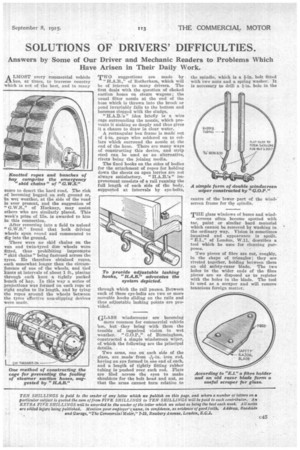SOLUTIONS OF DRIVERS' DIFFICULTIES.
Page 29

If you've noticed an error in this article please click here to report it so we can fix it.
Answers by Some of Our Driver and Mechanic Readers to Problems Which Have Arisen in Their Daily Work.
ALMOST every Commercial vehicle Las, at times, to traverse country which is not of the best, and in many eases to desert the hard road. The risk of becoming bogged on soft ground or, in wet weather, at the side of the road is ever present, and the suggestion of " G.W.S.," of Hackney, may assist others who are similarly placed. This week's prize of 15s. is awarded to him in this connection.
After reversing into a field to unload " G.W.S." found that both driving wheels spun round and commenced to dig into the ground.
There were no skid chains on the van and twin-tyred disc wheels were fitted, thus prohibiting impromptu "skid chains" being fastened across the tyres. He therefore obtained ropes, each somewhat longer than the circumference of one of the wheels, and tied knots at intervals of about 1 ft., placing through each knot a tightly packed bunch of hay. In this way a series of .projections was formed on each rope at right angles to its length, and by tying the ropes around the wheels between the tyres effective non-slipping devices were made.
TWO suggestions are made by
"H.A.B.," of Rotherham, which will be of interest to many drivers. The first deals with the question of choked suction hoses on steam wagons ; the usual filter nozzle at the end of the hose which is thrown into the brook or pond invariably falls to the bottom and becomes clogged with the sludge.
"H.A.l3.'s" idea briefly is a wire cage surrounding the nozzle, which prevents it sinking so deeply and thus gives it a chance to draw in clear water.
A rectangular box frame is mad6 out of j-in. gauge wire soldered on to collars which surround the nozzle at the end of the hose. There are many ways of constructing this device, and strip steel can be used as an alternative, rivets being the joining media.
The fixed hooks on the sides of bodies for the attachment of ropes for holding down the sheets on open lorries tire not always satisfactory. "H.A.B:s" improvement consists of a rail running the full length of each side of the body, supported at intervals by eye-bolts, through which the rail passes. Between each of these eye-bolts are two or more movable hooks sliding on the rails and thus adjustable lashing points are provided.
GLASS windscreens are becoming more common for commercial vehicle use, but they bring with them the trouble of impaired vision in wet weather. " G.O.P.," of Birmingham, constructed a simple windscreen wiper, of which the following are the principal deteile.
Two arms, one on each side of the glass, are made from iron rod, having an eye formed in one end of each, and a length of tightly fitting rubber tubing is pushed over each rod. Flats are filed across the eyes to make shoulders for the bolt head and nut, so that the arms cannot turn relative to the spindle, which is a +-in. bolt fitted with two nuts and a spring washer. It is necessary to drill a hole in the centre of the lower part of the windscreen frame for the spindle.
THE glass windows of buses and wind
screens often become spotted with tar, paint or similar hard material which cannot be removed by washing iii the ordinary way. Vision is sometimes impaired and appearance is spoilt. "E.I.," of London, W.11, describes a tool which he uses for cleaning purposes.
Two pieces of fibre are cut, roughly, in the shape of triangles; they are riveted together, holding between them an old safety-razor blade. The two holes in the wider ends of the fibre pieces are co disposed as to register with the boles in the blade. The tool is used as a scraper and will remove tenacious foreign matter.






























